Olympus OM-D E-M5 - Oh My Darling (Updated!)
The OM-D E-M5 is a new, gorgeous, retro-tastic Micro Four Thirds camera from Olympus. It is the first from Olympus to come with an electronic viewfinder, and is aimed at enthusiasts who want a serious MFT option. We've fallen deeply in love with this camera, here's why.
By HardwareZone Team -
Updated (23/3/12): We've updated our early preview of the Olympus OM-D E-M5 with full test results for this complete review. Enjoy!
Introduction
Olympus has been bringing retro back since the first PEN E-P1 first launched in 2009. It's proven so popular that other companies have sat up and taken note - check out Fujifilm's major push into retro designs with the X100, X10 and X-Pro1 cameras.
Still, if there's one thing that Olympus' Micro Four Thirds (MFT) PEN cameras have lacked, it's a built-in electronic viewfinder (EVF). Until today. Check out the new Olympus OM-D E-M5 Micro Four Thirds digital camera, one which not only has a built-in EVF but is also the world's first dust & splash-proof mirrorless system camera, sporting a 5-axis image stabilization system and a brand new 16-megapixel sensor. And it not only brings retro back but dials it up to 11 - the E-M5 is unbelievably beautiful.
To be clear, the camera's name is the E-M5, and it is the first in Olympus' new range of OM-D MFT cameras. The OM-D moniker is a reference to the classic OM series of film cameras which Olympus made from the '70s to the '90s (the new 'D' stands for 'Digital'). Among vintage camera lovers, the Olympus OM series is a classic, the cameras were such fine performers that used models are still sought after today. The last professional OM, the OM-4T (also known as the OM-4Ti), was discontinued in 2002. Time, it seemed, had left the OM series behind; but now, ten years later, Olympus has revived the OM lineage.
Although the PEN and OM-D series are both Micro Four Thirds cameras, Olympus wants to separate the two lines. The OM-D line is designed for the more-serious-than-PEN owners looking for a pro-like MFT camera with a built-in EVF, tough body and high image quality. The OM-D cameras is also designed for those who are willing to pay a little bit more for better quality. The E-M5 will be going for S$1,488 (body only), S$1,888 with 12-50mm lens kit and S$1,988 for the 14-42mm II R Lens & 40-150mm R double lens kit.

The Olympus OM-D E-M5 comes in black and silver, both equally beautiful we think.
Design & Handling
Olympus has been on a retro roll since the first PEN camera was released three years ago. While the Micro Four Thirds PEN cameras hewed closely to their PEN film camera predecessors, the OM-D E-M5 follows after the original OM film cameras, looking like a new model which has just rolled out of the factory. There's really nothing much to say about the E-M5's looks – it had us at hello.

See the family resemblance? This is the original Olympus OM-1 (the name was later changed from M-1 because of a dispute with Leica, which had its own M-series of cameras).
The Olympus OM-D E-M5 is a fun camera to use. That's not a technical term, but it's how we felt as we were using it. The camera feels good in the hands, with essential controls within quick reach. It's fast and responsive, reacting promptly to our demands. While the camera is slightly bigger and heavier than the E-P3, it still feels small and light. That said, it feels like the camera could have used a bit more breathing room, as some of its controls feel claustrophobic.
A Comfortable Camera
The Olympus OM-D E-M5 feels solid in the hands with a comfortable grip and balanced heft. The camera is dust and splash-proof. And while Olympus doesn't say it, it's probably quite knock-proof as well. That's because the interior cabinet is made of magnesium-alloy, as is the camera top, while the bottom is made of aluminum. The M.Zuiko Digital ED 12-50mm f/3.5-6.3 EZ kit lens is dust and splash-proof as well; combine it with the E-M5 and you've the most rugged mirrorless system camera in the world today.
The E-M5 feels good to hold, thanks to the front grip and the back thumb-rest. The thumb-rest may look exaggerated, but after using it we wouldn't want it any smaller. The flip-out OLED back monitor is excellent, while it may not provide the freedom that a side-articulating screen does, it's still better than a fixed screen. The screen is, like the PEN E-P3's, touch-sensitive and can be used to tap to shoot. It's a useful feature to have; it's much faster to simply tap on your subject to set focus and snap than to fiddle with the physical controls. You can also tap to set tracking AF on a subject, but best of all, you can tap to disable all touch controls altogether. This is more useful than you think, especially since it's easy to accidentally tap the screen from carrying the camera.
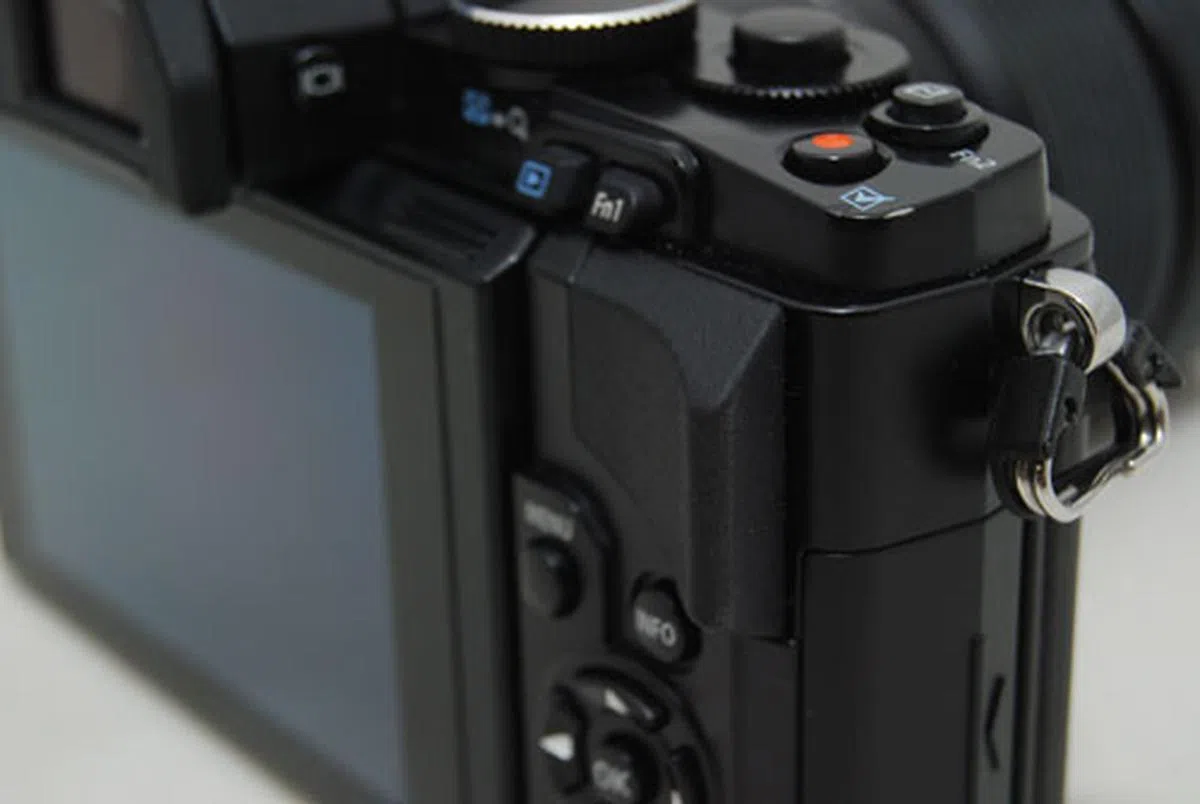 | 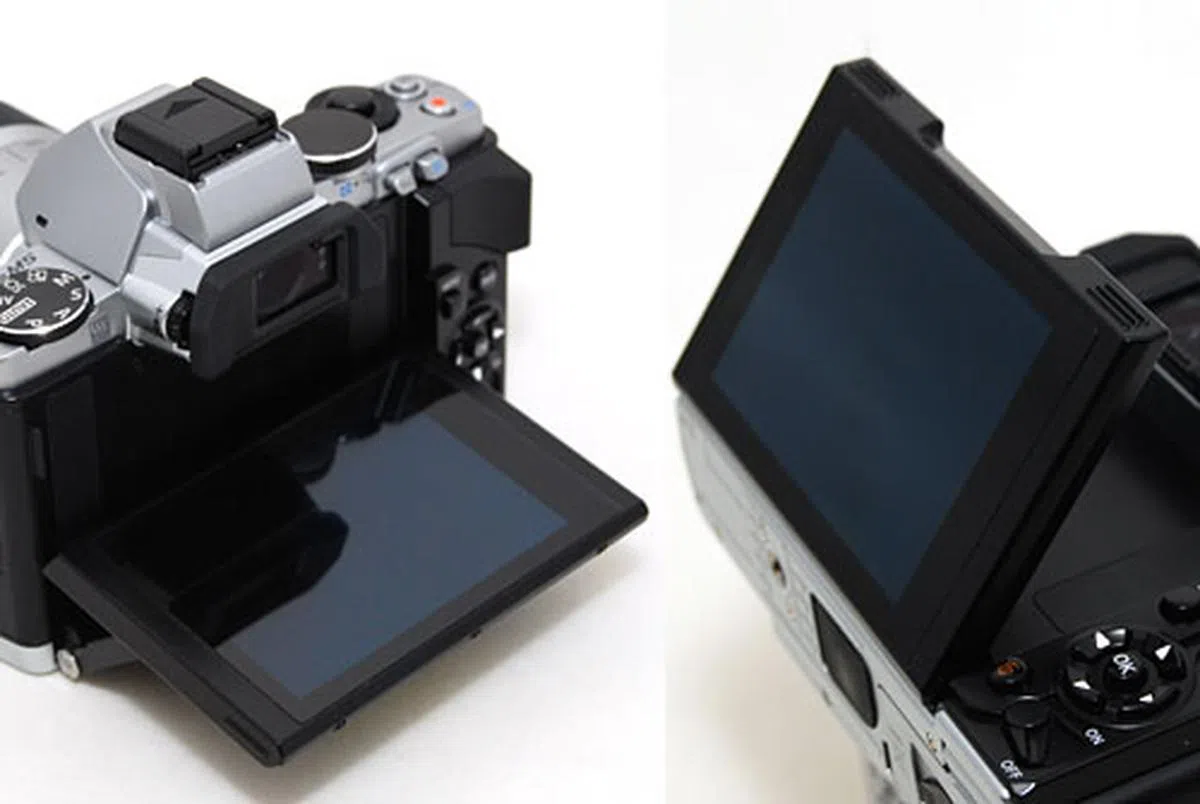 |
A 1.44M Dot Electronic Viewfinder
A first for Olympus Micro Four Thirds camera is the built-in electronic viewfinder (EVF) on the E-M5. That large block on top of the camera doesn't house a flash, in fact the E-M5 doesn't have one built in. Instead, you've a hot shoe and adapter rack on the top plate, while the back of it houses the LCD viewfinder. It has a 100% field of view and 1.44 million dots, with an eye sensor to detect when your eye is on the EVF and automatically switch between activating the rear-panel monitor and the EVF.
The benefits of having an EVF include the ability to see in brightly lit environments where the rear-panel monitor would be washed out. The E-M5's EVF works great. It refreshes quickly so the image always feels responsive, it feels up to date even in low light where there is little to no lag. While it'll never be as bright or as detailed as an optical viewfinder, an EVF brings several advantages – you can see more overlay information, browse menus inside of it, review images discreetly and see a live exposure preview before you shoot.

The hump on top of the E-M5 houses the electronic viewfinder, hot shoe adapter and accessory port. The camera does not have a built-in flash.
Twin Gear Shifts for the Manual Driver
The E-M5 handles beautifully for photographers who like to shoot manually. Settings can be accessed quickly via two methods; through an overlay menu and what Olympus calls the Super Control Panel (these two options should be quite familiar to PEN owners as they're essentially the same). Pressing the OK button in the middle of the d-pad brings up the overlay menu which will still let you watch the scene, and pressing the Live View button by the side of the EVF will bring up the Super Control Panel. Both menus give you access to important settings like ISO, white balance and AF drives.
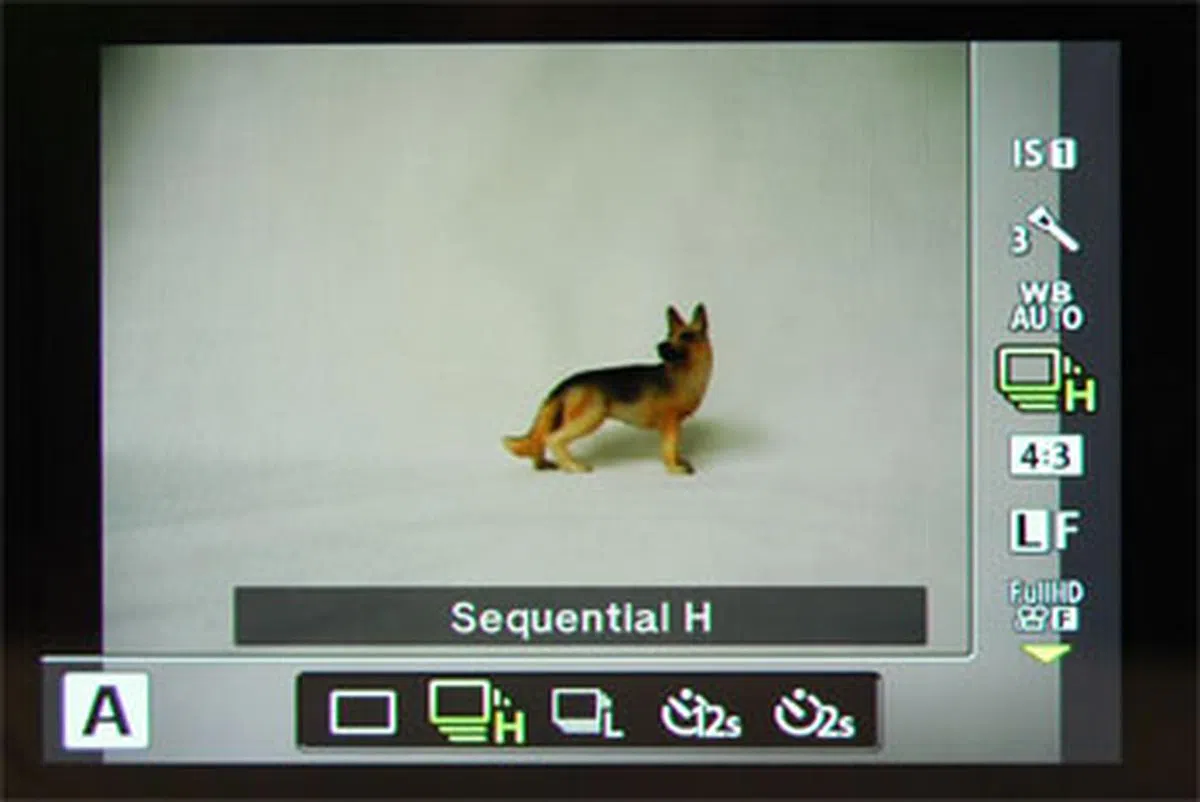 | 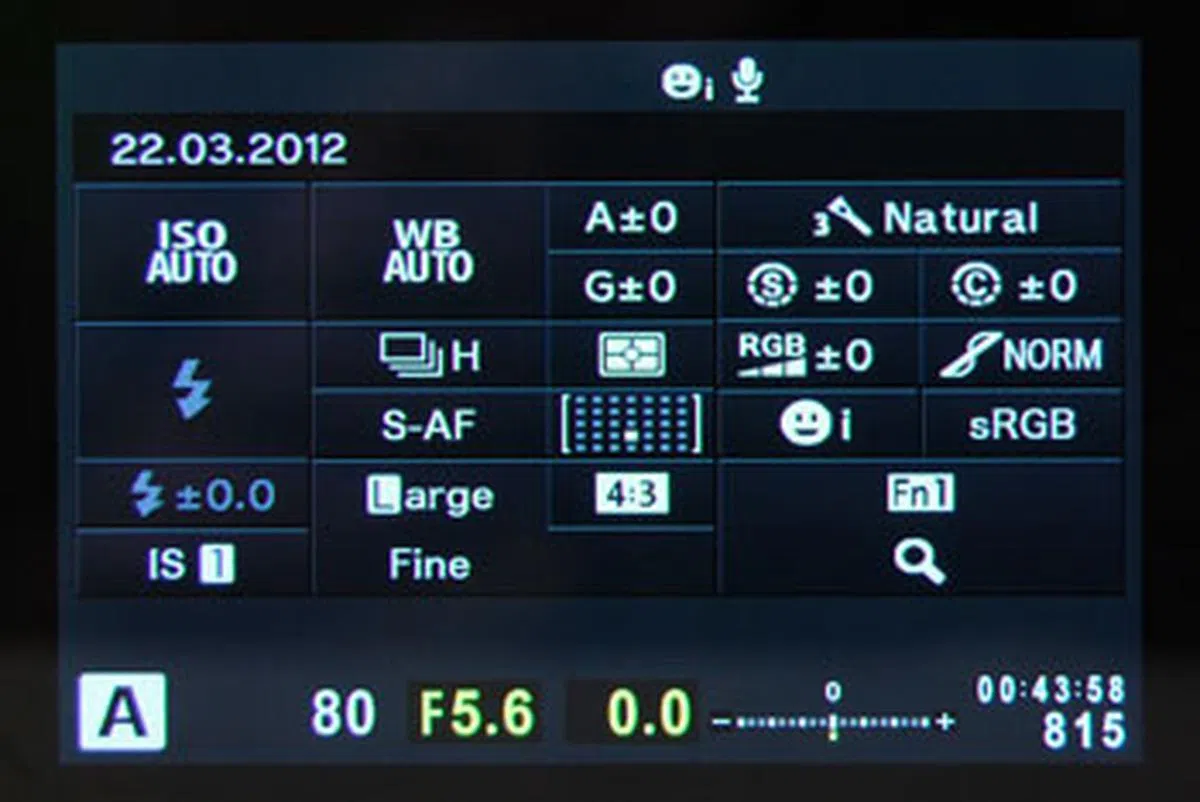 |
If quick access via menus isn't enough for you, the E-M5's physical controls are highly customizable. It comes with two customizable Function buttons to set off specific commands like ISO and AF/AE lock. But that's not all: Other buttons' default functions can also be switched, for example the movie Record button can also be customized, so can the right and down arrows on the d-pad (they trigger AF point selection by default).
One of the best features on the E-M5 body is the front and back control dials which overlap slightly on the top plate. They operate much like the control dials found on professional DSLR camera bodies and let you change settings on the fly. By default the back dial will control aperture or shutter speed when set to the respective priority modes, and the front decides exposure compensation. In Manual mode, the back dial controls shutter speed, while the front takes over aperture settings.

The twin control dials make operating the E-M5 akin to using a DSLR camera.
These functions can also be customized, but to a lesser extent than the other controls. They can also be used to set a highlight and shadows curve (akin to the Curves tool in Photoshop), offering a different way to control exposure. The two control dials may feel a little stiff, but that helps to lock them in place and not have them pushed around accidentally. Otherwise, it's pretty incredible how DSLR-like these two controls make the E-M5 feel.
While the placement of these two dials may feel inspired, the placement of the camera strap lugs are not – and this is crucial. In all our testing, we shot without a camera strap, because the strap will get in your way while you're holding the camera and trying to manipulate the shutter and front dial. While we're perfectly comfortable using a camera without a strap, we know not many will, and it's worth trying the E-M5 first with the strap on before you decide to get one to see if you can tolerate it.
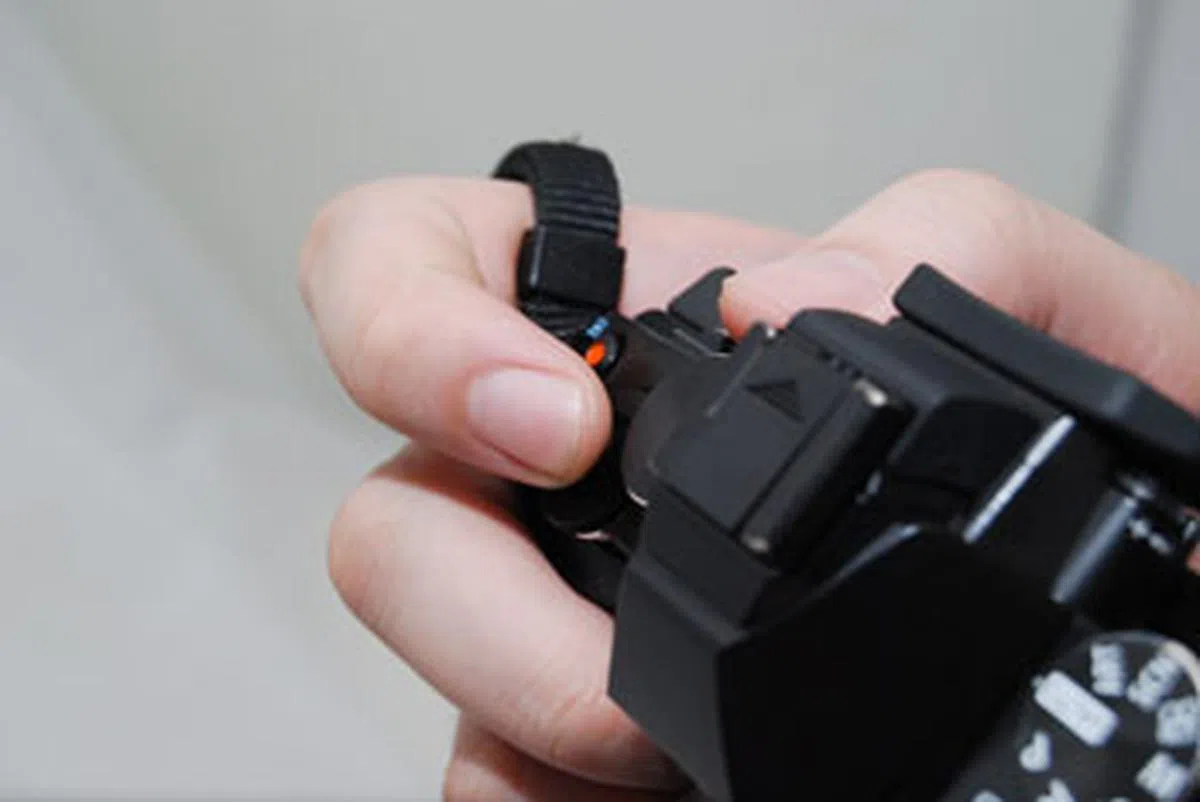 | 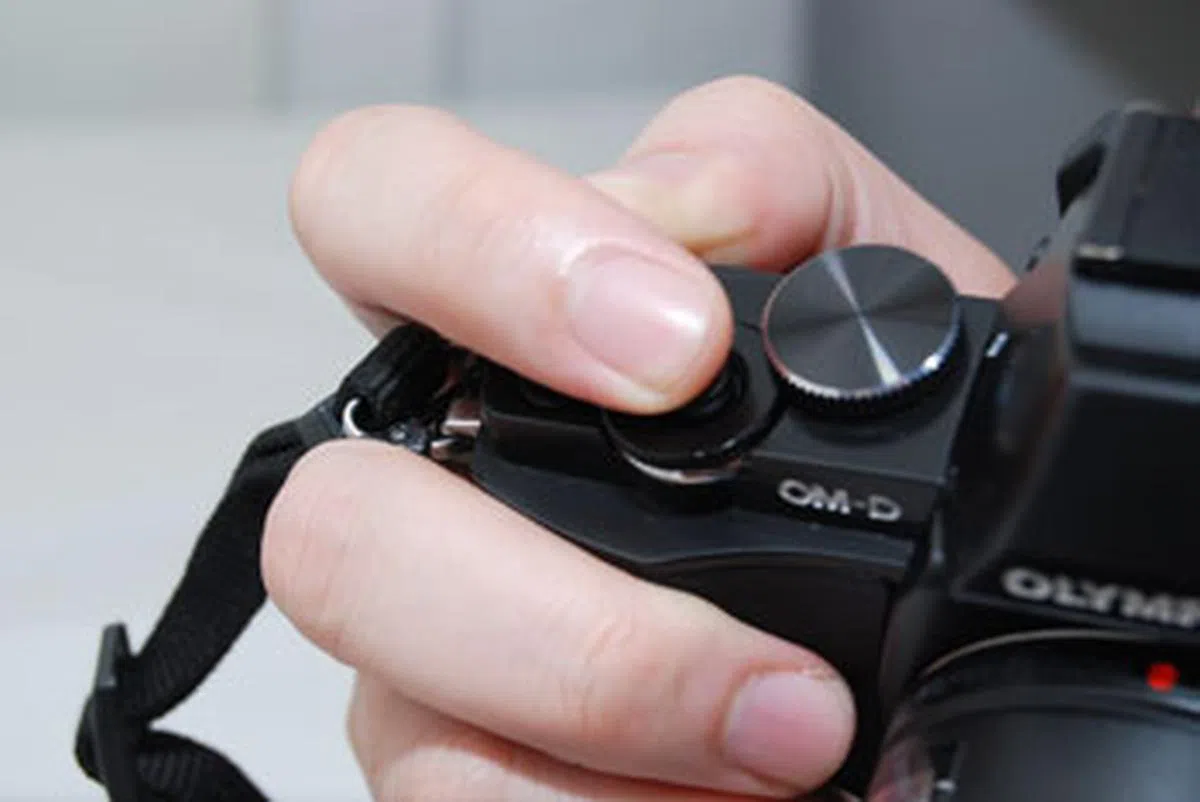 |
Really Small Buttons
Another feature you'll have to learn to tolerate is the ridiculously small buttons on the camera, the most obvious of which are the Play and Function 1 buttons. They're not just small; they sit recessed within a ledge and are difficult to press. The arrow keys on the d-pad are minute, even though they offer easy direct access to AF points (a very good feature, by the way), using them is always uncomfortable. Compared to the PEN E-P3, the E-M5's back controls feel cramped, and while it helps make a smaller camera, we feel we could have tolerated a slightly bigger body if it had meant more comfortable controls.
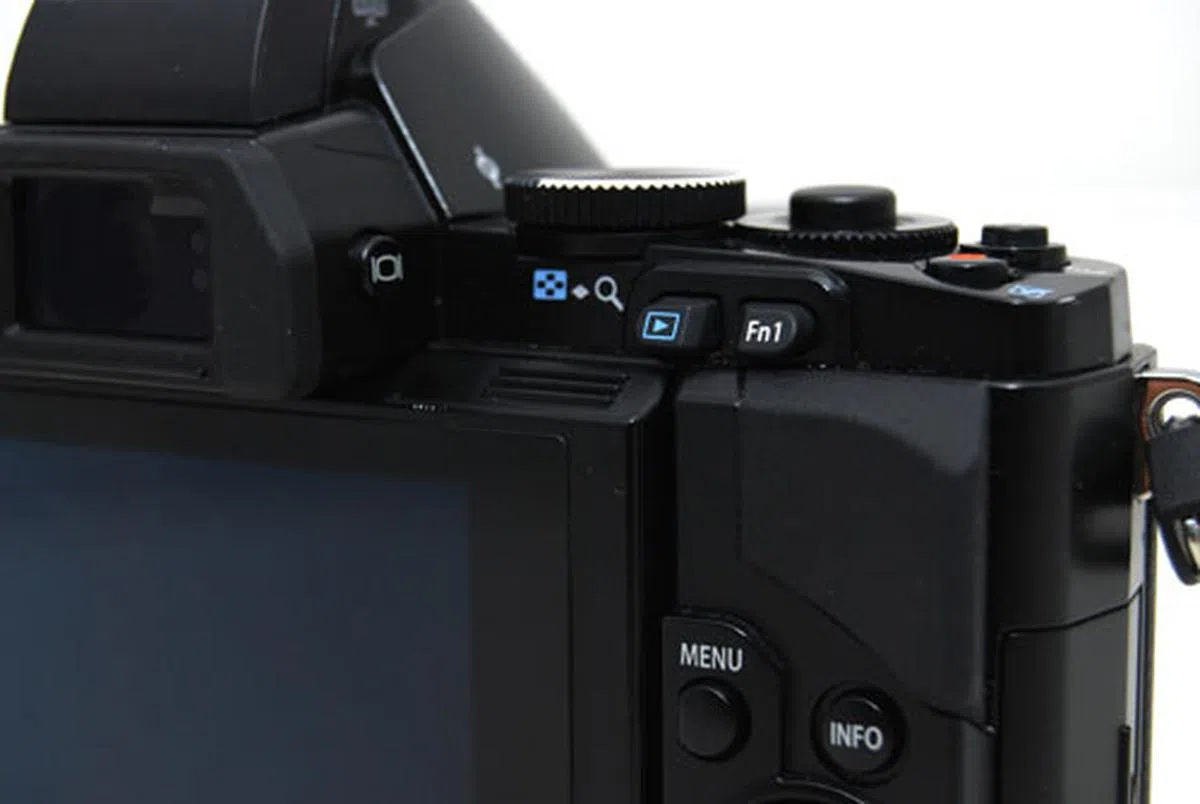 | 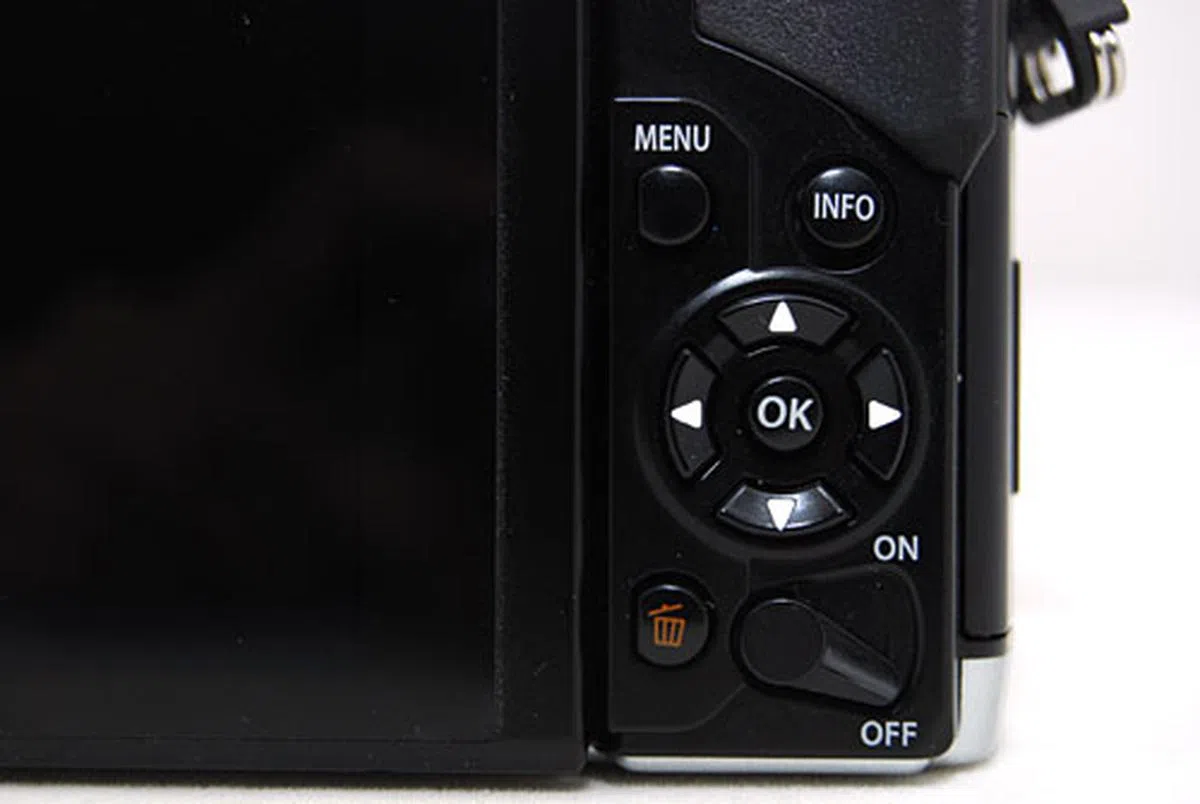 |
One last area of concern is the rubber covers which come with the E-M5. The one covering the EVF feels filmsy and we've knocked it out more than more just by glancing off it. The rubber strip covering the ports on the left side of the body is held to the body by a thin rubber strip which feels like it could snap off if twisted too far. The one covering the accessory port is the best-fitting one, it sits tightly on top of the port and needs a little effort to pry off.
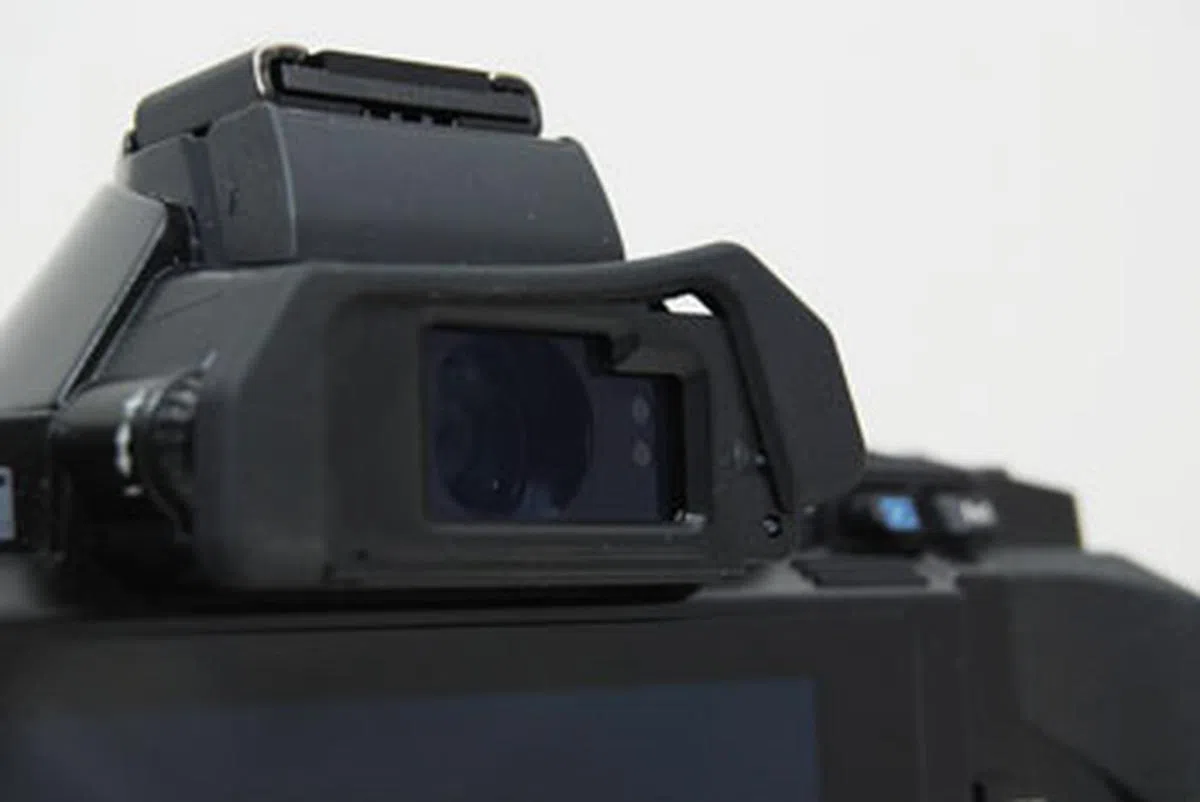 | 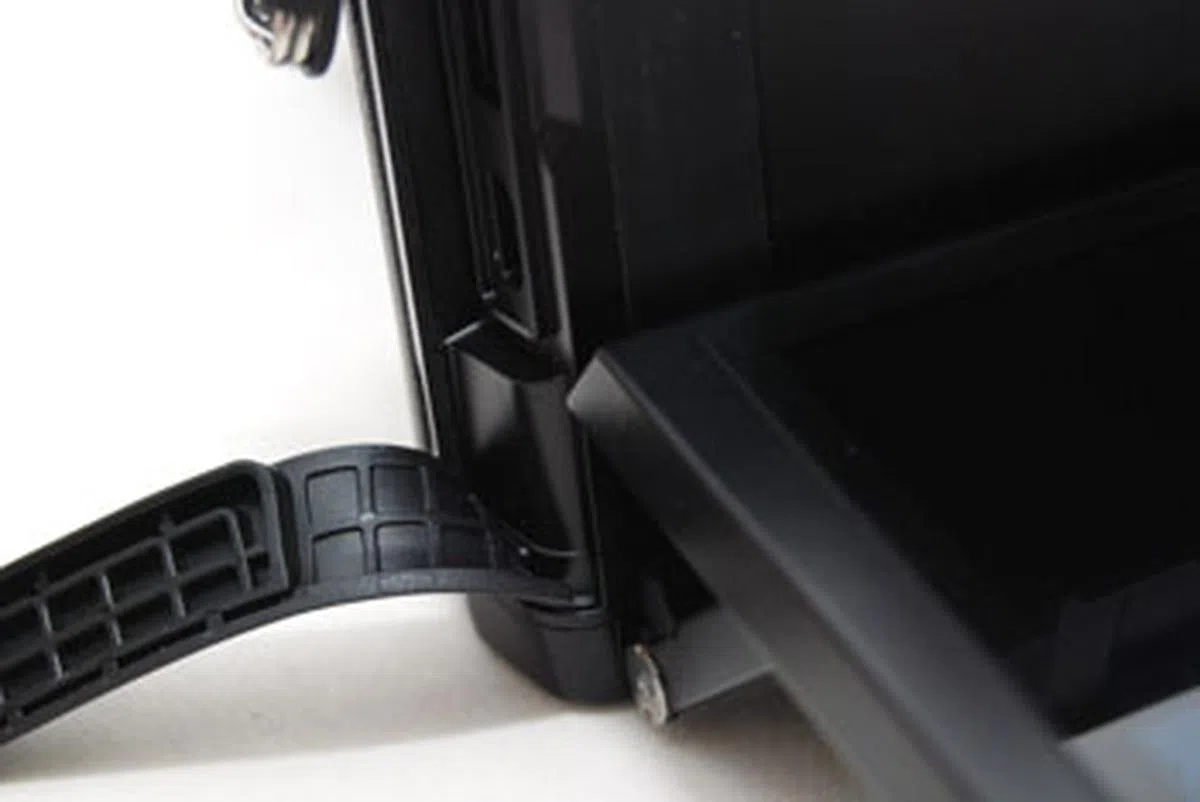 |
Design & Handling - Lens & Battery Grip
The E-M5 ships with a brand new M.Zuiko Digital ED 12-50mm f/3.5-6.3 EZ kit lens (24-100mm in 35mm equivalent). It offers a further range than the previous kits 14-42mm (28-84mm in 35mm equivalent) which have shipped with the PEN cameras. As a weather-sealed lens, it complements the E-M5 well; taken together the E-M5 becomes a camera you shouldn't be worried to carry into the (light) elements (it's weather-sealed, not weather-proof).
But like the Panasonic X 14-42mm lens which ships with the Panasonic GX1, we're not sold on the electronic zoom on the new lens. Our main grippe is that there are no focal length markings on the lens, unlike on a traditional lens. So there's no way to see, at a glance, just how far along you are on the zoom range before raising the camera to your eye and adjusting accordingly.
Still, while we dislike this disadvantage of the lens, it's because we're accustomed to using our lenses this way. If you don't have this habit, then it's likely you won't mind – there are certainly people who like the Panasonic X electronic zoom lens as much as we dislike it.
The Olympus lens handles better than the Panasonic X 14-42mm lens, in our opinion; because you can switch between manual and electronic zoom simply by sliding the zoom ring backwards or forwards. In electronic zoom mode the zoom ring only twists slightly left and right, the longer you hold in each direction the further the lens will zoom. This benefits videographers who'd prefer to have a smoother zoom then twirling the zoom ring will allow. In manual zoom the ring goes all the way round both ways.
The mode ring presents its own challenges because it's easy to slide it accidentally when holding or storing the camera, forcing you to look at the mode indicator to check which zoom mode you're in. Olympus actually solved this problem, but only for the third Macro mode on the lens; you have to press and hold the Macro button on the lens to be able to slide the zoom ring all the way to Macro. In our opinion the lens would have benefitted from a lock button for all three modes.
The Battery Grip: A Compelling Option

While the E-M5 feels good in the hands, it feels perfect with the optional HLD-6 power battery holder. While it adds size and heft to the camera, it also adds comfort, functionality and of course, battery life – with the additional battery the E-M5's lifespan is nearly doubled to 650 shots (as rated by CIPA). The HLD-6 battery holder doesn't come with any additional batteries. PEN owners, unfortunately, won't be able to use their existing batteries as the E-M5 uses a new battery type.
The battery holder comes with additional two additional shutter releases. The one in front sits on top of a prominent and comfortable grip; the one on the side is orientated for comfortable portrait shooting. The holder even comes with two additional control dials for use in portrait orientation, as well as two additional customizable Function buttons. Having the battery holder affixed also solves the strap problem somewhat; by providing a more prominent front grip your fingers can more comfortably push down the strap and reach beyond for the shutter without having the strap intertwine between them.
This battery holder is a first for a mirrorless system camera. While it makes the E-M5 less portable, it also transforms the camera into something resembling a high-end DSLR. It's an odd feeling to use a small Micro Four Thirds like a large DSLR camera, but it also feels really good for those used to the feel of a DSLR. While the HLD-6 is an optional accessory, it adds so much to the camera that it feels like it the battery holder should just come with it.
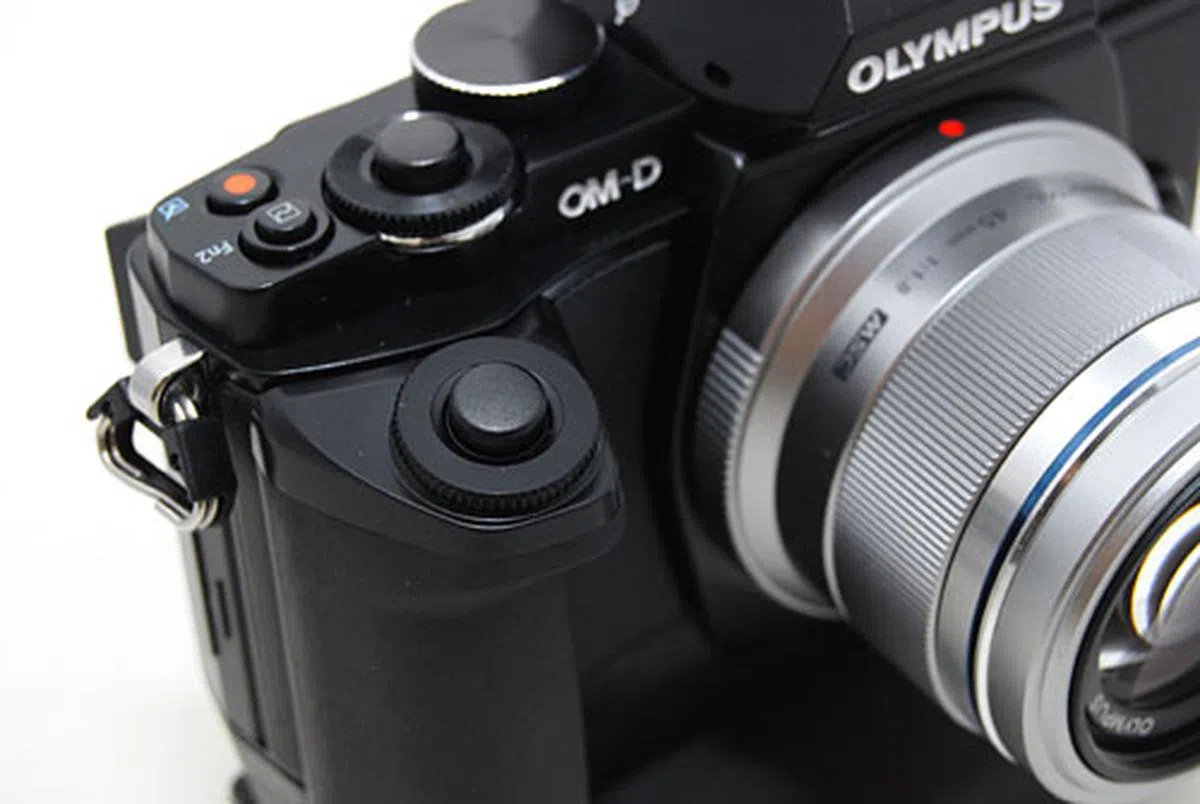 | 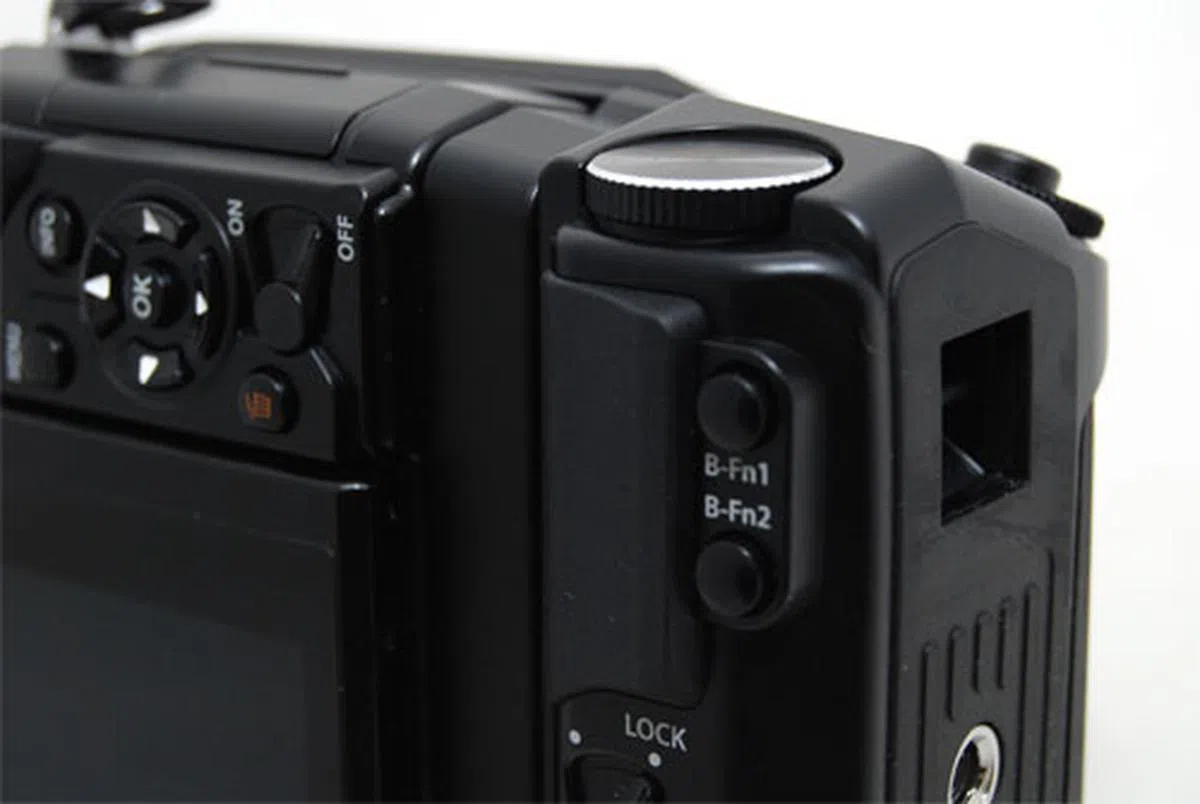 |
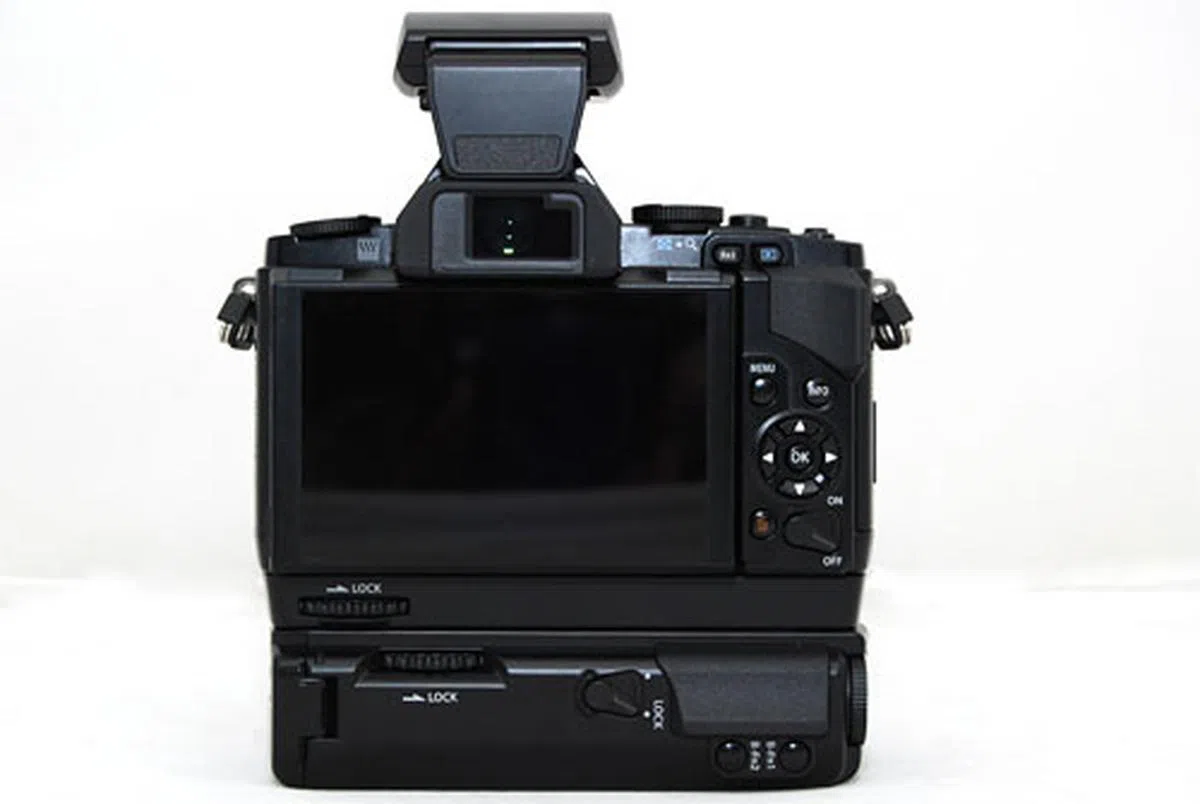 | 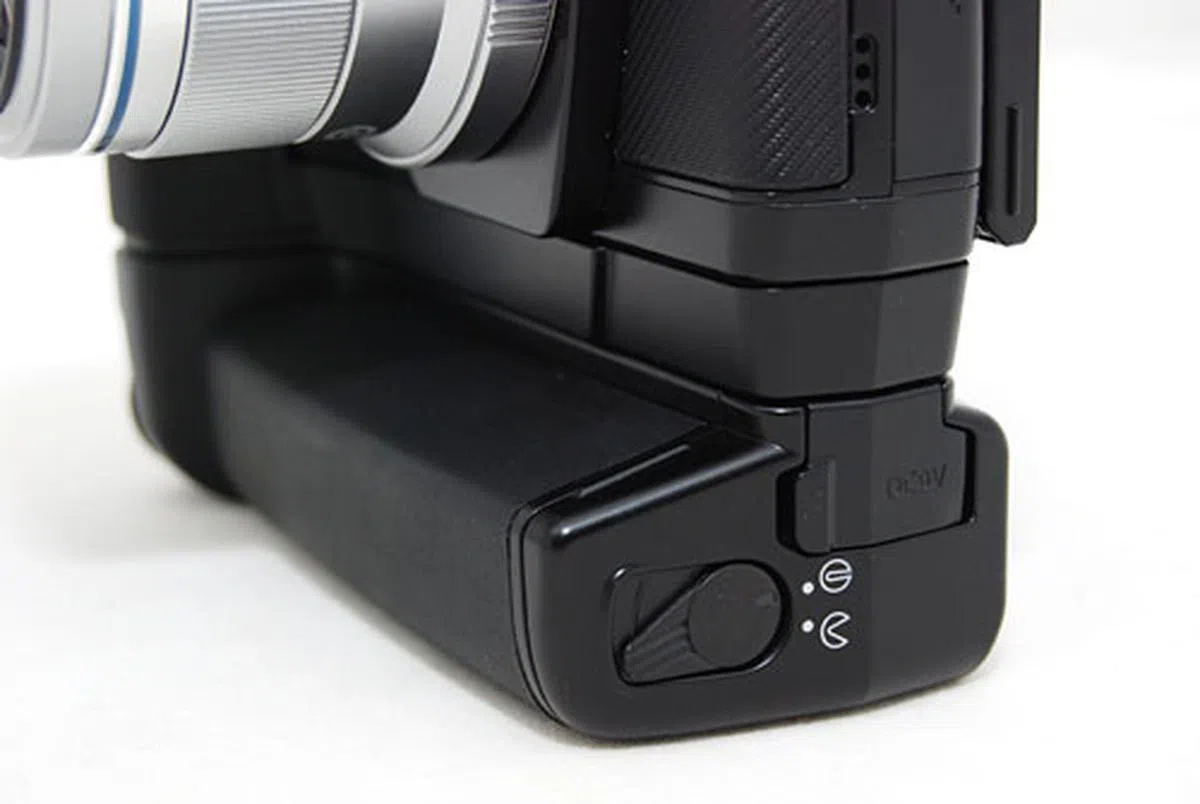 |
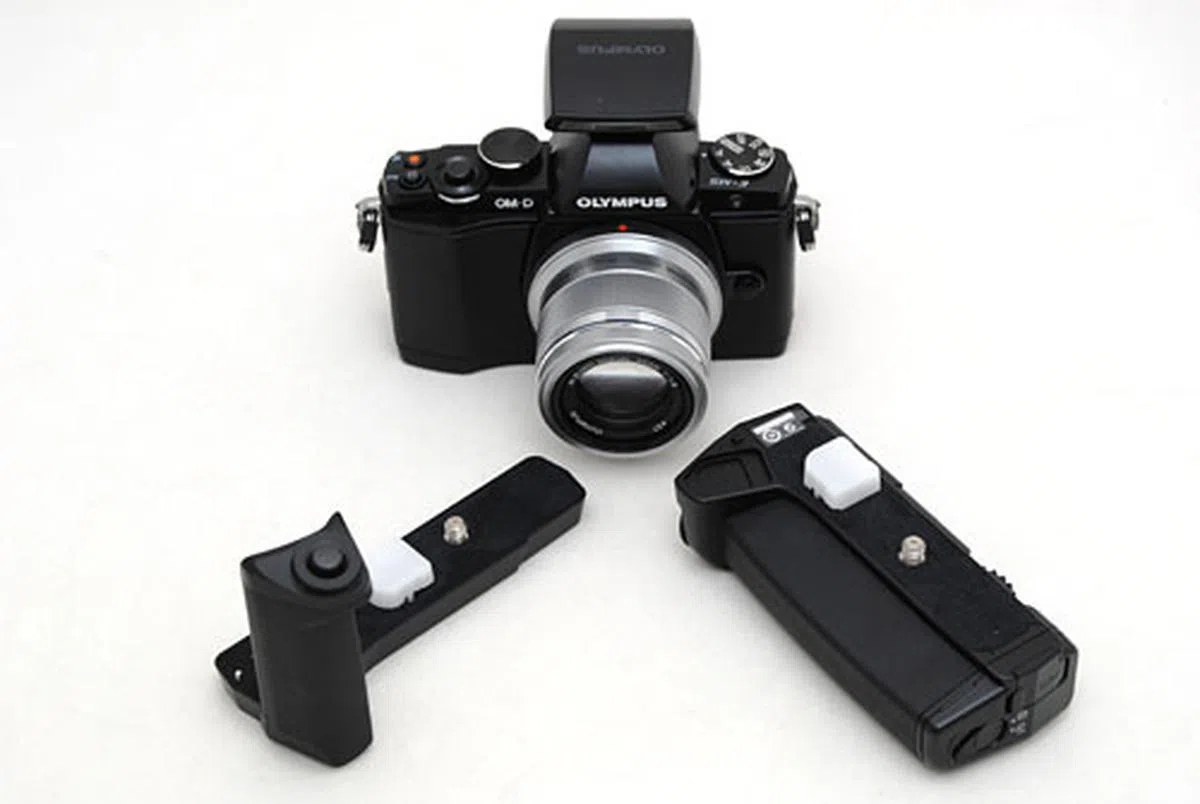 | 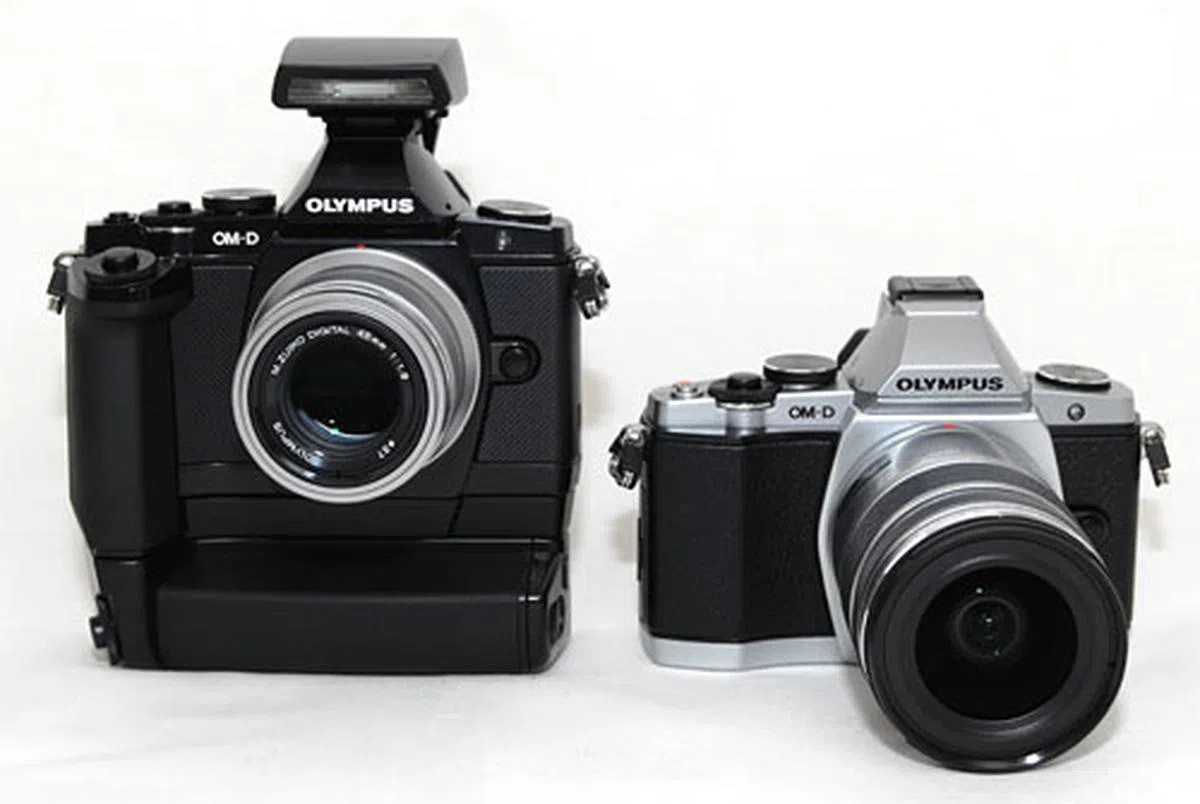 |
Image Performance
The OM-D E-M5's image performance is, in a word: Astounding. Image clarity has been increased from the E-P3, from approx. 1800 LPH (vertical and horizontal) to approx. 2200 LPH (vertical and horizontal). Noise performance has improved by unbelievable leaps and bounds, so unbelievable that it's redefined our beliefs about what a Micro Four Thirds (MFT) sensor can achieve. Images come with the famous Olympus colors, which make images look rich and seem to add additional depth to the greens and blues.
Now, to properly qualify that: This is still a MFT sensor. The image detail at lower ISO settings still doesn't match the best of what we see in APS-C sensors. But at higher ISO settings Olympus has pulled off some serious magic; the E-M5 can shoot up to such high levels with minimal grain appearing that it gives some APS-C cameras a run for their money. It's amazing how much detail is retained and how little noise is seen at high ISO levels.

f/2.8 at 90mm (35mm film equivalent), 1/100 sec, ISO6400. Click for full-resolution image.
Shooting with the E-M5 is a pleasure. Besides the ability to shoot at higher ISO sensitivities with confidence, the E-M5's auto-focus is fast and accurate. Like the E-P3, the E-M5 can even focus on faces and pin-point eyes as focal points. AF performance drops when shooting fast subjects in low-light, a challenging environment for any mirrorless system camera's contrast detect AF system, but it is surprisingly good in low-light for most other situations. The E-M5 makes it easy to change AF points, while shooting in Multi-AF mode all you need to do to manually take over AF point selection is to press any of the directions on the d-pad. To go back to Multi-AF mode, direct the AF point out of the AF grid.
The E-M5 comes with new 5-axis image stabilization, a first such system for mirrorless system cameras. We tried shooting ten second exposures without a tripod, not hand-held, but balanced on the edge of the camera and its protruded OLED monitor on some steps. While we tried to press the camera down onto the floor and hold it steady, we knew we would unconsciously introduce some camera shake with our hands. Miraculously, we got more sharp images than we should have, and we credit it to the image stabilization system.

f/13 at 40mm (35mm film equivalent), 10 sec, ISO200. Click for full-resolution image.
A Record High ISO Performance
The E-M5 shoots up to a record high ISO setting of ISO25,600, the highest ever from a Micro Four Thirds sensor (the previous record was ISO12,800, held by the Olympus E-P3 and Panasonic GX1). Just how much image noise is acceptable can be subjective and dependent on the photographer's needs, but based on what we see, we'd be confident of shooting with the E-M5 up to ISO6400, even ISO8000-ISO10,000 if we're shooting for low-resolution use. Grain can hardly be seen up to ISO6400 when viewed normally, and color noise hardly appears until ISO16,000 and above. ISO12,800 to ISO25,600 are generally too noisy to be used.
What's interesting is that while Olympus has managed to keep a very tight and impressive lid on image noise at high ISO levels, it doesn't seem to have improved ISO performance much at lower ISO settings. If we pixel-peep, we see noise appearing from ISO800 onward, at ISO1600 detail smudging becomes more apparent (again, this is if we pixel-peep). In consequence, if we need absolutely clean images for large prints or publication, we'd cap shooting at ISO800 and below.
 |  |
We've seen some banding appear in some very high ISO shots. They don't always appear, and not always at the same settings, for example, the shots below were shot at ISO16,000 and ISO10,000. This is something you can see when reviewing your images on the OLED monitor, so it's worth checking your high ISO shots.
At the risk of sounding like a broken record: the E-M5's high ISO performance is astounding. While we would have preferred to see even cleaner images at lower ISO settings from ISO800-ISO1600, the ability to shoot up to ISO3200-ISO6400 with such low noise showing is nothing short of remarkable for a Micro Four Thirds sensor. Olympus has really upped the game here.
Sample Photographs
These are sample photographs shot with the Olympus OM-D E-M5. The photos have not been post-processed and are copyright to SPH Magazines. They are provided for your reference only and we ask that you do not reproduce them elsewhere. Click for the full-resolution images.

f/2.8 at 90mm (35mm equivalent), 1/3200 sec, ISO200. Click for full-resolution image.

f/11 at 70mm (35mm equivalent), 1/100 sec, ISO400. Click for full-resolution image.

f/7.1 at 24mm (35mm equivalent), 1/125 sec, ISO200. Click for full-resolution image.

f/6.3 at 80mm (35mm equivalent), 1/250 sec, ISO200. Click for full-resolution image.

f/5.6 at 40mm (35mm equivalent), 1/80 sec, ISO12800. Click for full-resolution image.

f/2.8 at 90mm (35mm equivalent), 1/100 sec, ISO4000. Click for full-resolution image.

f/2.8 at 90mm (35mm equivalent), 1/100 sec, ISO2500. Click for full-resolution image.

f/6.3 at 100mm (35mm equivalent), 1/125 sec, ISO25600. Click for full-resolution image.
Conclusion
There's just something about the Olympus OM-D E-M5.
We could list its specs: 16MP image sensor, 5-axis image stabilization, weather-resistant body. We could tell you how well the camera handles with the twin control dials, quick AF speed and easy AF point selection. We could wax lyrical about its gorgeous, retro-inspired look. We could look at its images' beautiful colors and remarkable high ISO performance.
But it's when these elements are brought together that something altogether new is born: Charm. Any photographer would be hard-pressed not to have fun shooting with the E-M5. The mostly well-placed controls let you give it swift commands which are promptly obeyed. Its quick and accurate auto-focus, together with the excellent image stabilization and image quality at higher ISO speeds, conspire to help you catch the most fleeting of moments.
The E-M5 is not perfect, of course. The d-pad is cramped, the Play and Function 1 buttons are impossibly small and the camera strap lugs are placed in the most obstructive way possible. Even though ISO settings can go up to previously unseen levels with little noise showing, we would have also liked to see clearer results at lower ISO ranges around ISO800. But the camera is also light, compact, responsive, easy to use and delivers very good images. In the end, this is a capable camera you can trust, and that makes all the difference.
The Olympus OM-D E-M5 vs. the World
While it's obvious that we love the camera (did the title give it away?), the one thing that gives us pause is the fact that the E-M5 is substantially pricier than the E-P3, Olympus' previous highest-end Micro Four Thirds camera. The E-P3 with 14-42mm single lens kit launched at S$1,298, the E-M5 with 12-50mm lens kit is launching at S$1,888, which is a S$590 difference. The E-P3 with 14-42mm and 40-150mm double lens kit launched at S$1,548, the E-M5 with the same double lens kit is launching at S$1,988, which is a smaller S$440 difference. If you already own Micro Four Thirds lenses, the E-M5 body alone is going for S$1,488.
We think that a S$400 difference between two models is reasonable, especially when one model offers much more than the other. But at near S$2000, the E-M5 is in the same pricing ballpark as the Sony NEX-7, selling for S$1999 with a 18-55mm kit lens. The Sony NEX-7 is also a high-performing, feature-rich camera, packing a bigger 24MP APS-C sensor with a maximum shooting speed of 10fps. Its Tri-Navi control system also offers quick and intuitive ease of use - it's definitely no slouch when compared to the E-M5.
The one definitive edge the E-M5 offers against the NEX-7 is the system; Micro Four Thirds offers the richest selection of native and third-party lenses for a mirrorless system today, while the NEX system is still in much need of native lenses. Sony has an A-mount adapter, which will let you mount existing A-mount DSLR lenses onto the NEX cameras and retain auto-focus and auto-metering, but the adapter is huge.
The E-M5 is also nearly the same price as the Canon 60D (S$2049 with 18-135mm kit lens) and Nikon D7000 (S$2149 with 18-105mm kit lens) DSLR cameras. To be fair, neither are mirrorless system cameras, but with their larger APS-C sensors and more comfortable controls, they offer a great shooting experience without compromise - except for size and weight. And that's entirely the point of mirrorless system cameras, if you want the best in performance, get a DSLR camera, but by doing so you trade portability and comfort for power. If you want something that's good enough and yet still portable, get a mirrorless system camera.
Our articles may contain affiliate links. If you buy through these links, we may earn a small commission.

